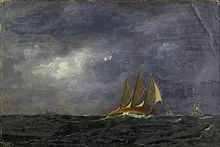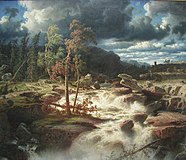Marcus Larson

Simon Marcus Larson (born January 5, 1825 in Örsätter , Åtvidaberg , Östergötland , † January 25, 1864 in London ) was a Swedish landscape painter from the Düsseldorf School .
Career
After attending the Linköping Cathedral School and starting a saddlery apprenticeship in 1841, Larson, who grew up as the second youngest of a family with seven children, studied at the Stockholm Art Academy , then in Copenhagen with the marine painter Vilhelm Melbye . Back in Stockholm he became friends with the painters Per Wilhelm Cedergren (1823-1896), Morten Müller and Kilian Zoll . In 1849 he went on a study trip to Norway . In 1850 he married Adelaine Roos, a merchant's daughter born in 1827; the marriage failed in 1860. In 1851, decorated with the royal medal for his marine and landscape paintings, he went on a trip to the East and North Sea in the wake of the Swedish Prince Oskar , which influenced his artistic development. His friend, the painter and photographer Gustaf Carleman , created photographs that Larson then used for his marine pictures .
From 1852 to 1855 - interrupted by summer stays at home - as a private student, Larson attended Andreas Achenbach's studio in Düsseldorf , whose “sea storm and doomsday depictions” he imitated and enhanced with great success. In the artists' association Malkasten , of which he is listed in 1854 and 1855, Larson and his compatriot Josef Wilhelm Wallander took part in the theater production Pannemann's Traum , in which they played personifications "Sweden and Norway", while the Dutch Henry Lot "Holland" and the German-American Charles Wimar represented "America". In the years 1855/1856 Larson stayed in Paris . At the world exhibition there , he exhibited his painting Waterfall , which was sold immediately. In the Louvre he was deeply impressed by his encounter with paintings by Ruisdael . In 1858 he settled - as a celebrated “ genius ” at the height of his recognition - in Vimmerby ( Småland ) in southern Sweden , on the outskirts of which he was able to have a stately villa built. His artistic and economic success was based on the social need to see the landscape - represented by wild mountain rivers and dangerous seashores - interpreted as a "Swedish landscape" in the sense of an awakening national romanticism, theatrically exaggerated and staged through painting .
After a few years in Sweden, in which his marriage and his attempt to start a painting school failed, he set off again in 1860, first to Borgå ( Grand Duchy of Finland ), where he stayed as the guest of the poet Johan Ludvig Runeberg , then to Saint Petersburg ( Russian Empire ). He successfully painted and sold his pictures there again. The St. Petersburg Academy of Art then accepted Larson, the first Swede, as an honorary member. He then traveled from Saint Petersburg via Düsseldorf (1861) to London to take part in the 1862 World's Fair . During this time he fell into a crisis. The initial interest in his work decreased significantly, so that he had to offer his pictures on street corners. Almost penniless, he died of tuberculosis in London in 1864 . On February 1, 1864, he was buried in a Woking cemetery.
Larson's son, Carl Robert Magnus Larson (1861–1936), also became a painter; Carolina Hammarlund († 1918) had born him, a maid of the Larson family.
Works (selection)
- Self-portrait , 1850
- Sailing ship , 1852
- Ship on a Stormy Sea , 1852
- Forslandskap , 1854
- Forest stream in a valley in Sweden , 1855
- Fishing by torchlight , 1855
- Waterfall in Småland , 1856, Larson's most famous painting
- Storm on the Bohuslän Coast , 1857, Stockholm National Museum
- Cliff landscape with waterfall , 1859, Stockholm National Museum
- Burning ship on the night sea
- Steamship in the sunset
gallery
Contemporary reception
August Theodor Blanche wrote about Larson in 1857 in the Illustrerad Tidning :
“The main character in Larson's artistry is a wild, sometimes irrepressible, but always great force that irresistibly carries the visitor along, arousing admiration and amazement at the same time. He doesn't belong to any school, no manner; he knows no other teacher than nature, whose traces he also follows, almost as tirelessly as she herself. "
literature
- Friedrich von Boetticher : Painters works of the nineteenth century. Contribution to art history . Volume 1, Dresden 1895, p. 811 ( digitized version ).
- Axel Gauffin: Marcus Larson. Ett svenskt geni . Stockholm 1943.
- Boo von Malmborg: S Marcus Larson . In: Svenskt biografiskt lexikon , Volume 22 (1977-1979), p. 278.
- Wend von Kalnein (ed.): The Düsseldorf school of painting . Verlag Philipp von Zabern, Mainz 1979, ISBN 3-8053-0409-9 , pp. 384-386.
- Bettina Baumgärtel (Ed.): The Düsseldorf School of Painting and its International Radiance 1819–1918 . Two volumes, Michael Imhof Verlag, Petersberg 2011, ISBN 978-3-86568-702-9 ; Volume 1: pp. 48, 276, 363, 364, 434; Volume 2: p. 348 (Catalog No. 288).
Web links
- Simon Marcus Larson , biography on the wiw.net portal(in English)
- Britt Svensson: Marcus Larson, 1825–1864 , biography in the portal kulturarvostergotland.se (in Swedish)
Individual evidence
- ^ Wend von Kalnein, p. 384
- ↑ Sabine Schroyen: "A true brotherhood seems to reign among them." - The artists' association Malkasten and its international members . In: Bettina Baumgärtel, p. 276
- ↑ Title: Pannemann's Traum: Operagout; with a preliminary u. a musical disadvantage (theater performance in the Malkasten, 1855) , website in the portal zvdd.de (Central Directory of Digitized Prints), accessed on September 13, 2014
- ↑ Marcus Larson, Self-Portrait 1850 , website in the portal bukowskis.com , accessed on September 13, 2014
- ^ Friedrich Müller, Karl Klunzinger: The artists of all times and peoples . Second volume (F – L), Verlag von Ebner & Seubert, Stuttgart 1860, p. 557 ( online )
- ↑ Bettina Baumgärtel, Volume 2, p. 348, catalog no. 288
- ↑ Quoted from: Wend von Kalnein, p. 386, as well as exhibition catalog “Düsseldorf and the North”, 1976, catalog no. 112
| personal data | |
|---|---|
| SURNAME | Larson, Marcus |
| ALTERNATIVE NAMES | Larson, Simon Marcus (full name) |
| BRIEF DESCRIPTION | Swedish landscape painter from the Düsseldorf School |
| DATE OF BIRTH | January 5, 1825 |
| PLACE OF BIRTH | Örsätter , Åtvidaberg , Östergötland |
| DATE OF DEATH | January 25, 1864 |
| Place of death | London |





